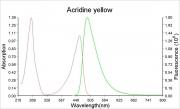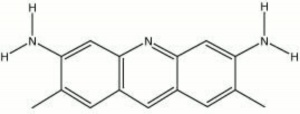Difference between revisions of "Acridine yellow"
Jump to navigation
Jump to search
(username removed) |
(→Risks) |
||
| (3 intermediate revisions by 3 users not shown) | |||
| Line 2: | Line 2: | ||
== Description == | == Description == | ||
| − | Yellow crystals that produce dark brown solution. Dilute solutions of acridine yellow are fluorescent. Acridine yellow is used as a [ | + | Yellow crystals that produce dark brown solution. Dilute solutions of acridine yellow are fluorescent. Acridine yellow is used as a [[fluorochrome|fluorochrome]] for biological staining. It has a mean excitation wavelength of 470 nm (blue) and a mean emission wavelength of 550 nm (Wolbers et al., 1990). |
== Synonyms and Related Terms == | == Synonyms and Related Terms == | ||
| Line 10: | Line 10: | ||
[[[SliderGallery rightalign|acridine yellow.jpg~Chemical structure]]] | [[[SliderGallery rightalign|acridine yellow.jpg~Chemical structure]]] | ||
| − | == | + | == Risks == |
| − | + | Strongly irritating to skin and mucous membranes. | |
| + | |||
| + | Fisher Scientific: [https://fscimage.fishersci.com/msds/36209.htm#:~:text=MSDS%20Name%3AAcridine%20Yellow%2C%2098%25%20%28UV-Vis%29%20Catalog%20Numbers%3AAC400240000%2C,AC400240050%2C%20AC400240250%2C%20AC400241000%20Synonyms%3AC.I.%2046025%3B%203%2C6-Diamino-2%2C7-Dimethylacridine%20Hydrochloride. MSDS] | ||
| − | + | == Physical and Chemical Properties == | |
| − | Maximum emission wavelength = 550 nm | + | * Soluble in ethanol, ether, hydrocarbons, carbon disulfide, boiling water. Insoluble in water, benzene. |
| + | * Maximum absorption wavelength = 470 nm; | ||
| + | * Maximum emission wavelength = 550 nm | ||
{| class="wikitable" | {| class="wikitable" | ||
| Line 27: | Line 31: | ||
|- | |- | ||
! scope="row"| Melting Point | ! scope="row"| Melting Point | ||
| − | | 281 | + | | 281 C |
|- | |- | ||
! scope="row"| Molecular Weight | ! scope="row"| Molecular Weight | ||
| Line 33: | Line 37: | ||
|} | |} | ||
| − | == | + | ==Resources and Citations== |
| − | |||
| − | |||
| − | |||
| − | |||
| − | |||
| − | |||
| − | |||
| − | |||
| − | |||
| − | |||
* Richard C. Wolbers, Nanette T. Sterman, Chris Stavroudis, ''Notes for Workshop on New Methods in the Cleaning of Paintings'', J.Paul Getty Trust, Los Angeles, 1990 | * Richard C. Wolbers, Nanette T. Sterman, Chris Stavroudis, ''Notes for Workshop on New Methods in the Cleaning of Paintings'', J.Paul Getty Trust, Los Angeles, 1990 | ||
| − | * | + | * Fisher Scientific at: https://www1.fishersci.com/catalogs/acrosgroup.jsp?catalogParamId=8013896&catalogParamType=AG mp = >400C |
[[Category:Materials database]] | [[Category:Materials database]] | ||
Latest revision as of 09:05, 24 April 2022
Description
Yellow crystals that produce dark brown solution. Dilute solutions of acridine yellow are fluorescent. Acridine yellow is used as a Fluorochrome for biological staining. It has a mean excitation wavelength of 470 nm (blue) and a mean emission wavelength of 550 nm (Wolbers et al., 1990).
Synonyms and Related Terms
CI 46025; 3,6-diamino-2,7-dimethylacridine hydrochloride
Risks
Strongly irritating to skin and mucous membranes.
Fisher Scientific: MSDS
Physical and Chemical Properties
- Soluble in ethanol, ether, hydrocarbons, carbon disulfide, boiling water. Insoluble in water, benzene.
- Maximum absorption wavelength = 470 nm;
- Maximum emission wavelength = 550 nm
| Composition | C13H11N3 |
|---|---|
| CAS | 135-49-9 |
| Melting Point | 281 C |
| Molecular Weight | mol. wt. = 273.76 |
Resources and Citations
- Richard C. Wolbers, Nanette T. Sterman, Chris Stavroudis, Notes for Workshop on New Methods in the Cleaning of Paintings, J.Paul Getty Trust, Los Angeles, 1990
- Fisher Scientific at: https://www1.fishersci.com/catalogs/acrosgroup.jsp?catalogParamId=8013896&catalogParamType=AG mp = >400C

